Macro Monthly The case for commodities
An allocation to commodities is sometimes considered in building portfolios during times of high inflation. However, it is a volatile asset class. Here, the multi-asset strategy team provides an outlook for the asset class.
Highlights
Highlights
- Commodities and commodity-linked equities were among the few standout performers in the first half as inflation disrupted most asset classes.
- Positioning in these assets has been curbed recently due to growing fears of a recession.
- However, commodity-linked assets remain attractive, as these exposures are inexpensive and we believe sentiment has deteriorated much more than fundamentals.
- In our view, global economic activity is decelerating but not yet contracting, and supply growth in commodities is likely to remain constrained in the near term.
- Importantly, Chinese growth is picking up as developed-market activity moderates.
The first half of 2022 demonstrated that commodities and commodity-linked equities are crucial for building resilient portfolios that can thrive in a high inflation environment (Exhibit 1).
However, these assets are also highly volatile and have suffered a substantial drawdown in recent weeks. We believe these market moves have been exacerbated by a large fall in speculative positioning amid increased concern about a future recession.
Now that speculative positioning has been curbed, the current fundamental drivers of the market can reassert themselves. Commodity markets are generally much less forward-looking than stocks and longer-term bonds, since they reflect current supply/demand conditions. As such, these exposures may perform well in a late-cycle environment where demand is slowing, but positive – so long as supply remains limited. That is the backdrop we expect will prevail over the near term, particularly for energy- linked assets. We believe pullbacks are likely to be buying opportunities so long as the onset of a recession is not imminent.
And in the medium term, commodity demand – particularly copper – is likely to need to rise for countries to both secure energy independence and to decarbonize the energy system. The potential magnitude of this required public and private investment, in our view, puts a higher floor under commodity prices that may somewhat offset the traditional cyclical risks.

Related
Macro updates
Macro updates
Keeping you up-to-date with markets
Exhibit 1: Standout performance from commodities in 1H 2022 (%)
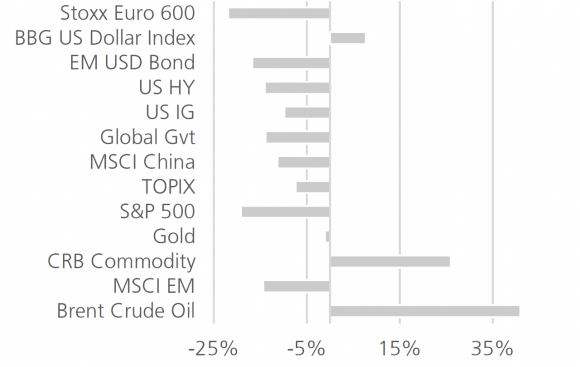
Exhibit 2: Low inventories imply high oil prices
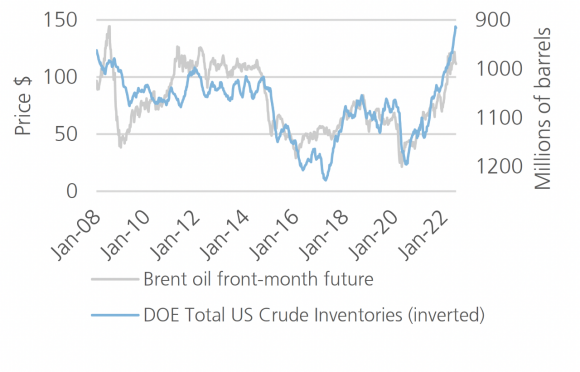
Commodity demand may get boost from China
Commodity demand may get boost from China
In our view, global economic activity is decelerating, but not to the point of an outright contraction in demand that shifts commodity markets from deficits to surpluses on a sustained basis.
Importantly, China is unlike nearly all major regions in that activity is poised to improve. Beijing’s willingness to deliver measured but meaningful stimulus is not in question, in our view. Better public health outcomes will allow for evidence of this support to appear in the data. China is the dominant driver of demand for many commodities, so this positive inflection may meaningfully offset the slowing in developed- market demand growth.
Outside of China, the policy outlook is mixed at present. On the one hand central banks have signaled or embarked upon aggressive rate hiking campaigns to cool activity and inflation. But on the other hand, fiscal authorities are largely opting for subsidies that allow for energy demand to be sustained, rather than energy-conservation measures.
Supply side likely to stay subdued
Supply side likely to stay subdued
Resilient demand coupled with a starting position of low inventories (Exhibit 2) in crude and refined products is a recipe for higher oil prices in the absence of supply growth.
US shale companies do not want to expand aggressively, prioritizing profitability over production growth to make up for last cycle’s excessive investment and prolonged period of poor returns for shareholders. Even if they did, any expansion plans would also be constrained by shortages of required inputs such as steel pipes and frac sand. The US is releasing barrels from the Strategic Petroleum Reserve to help mitigate shortages now, but this flow is slated to stop in the fourth quarter.
In the event of a ceasefire between Russia and Ukraine, we would not expect the petrostate’s access to global energy markets to improve. Russian production has surprised to the upside relative to initial post-invasion estimates, but sanctions not yet in effect may place more downward pressure on output going forward.
In theory, OPEC+ members like Saudi Arabia and the United Arab Emirates have ample spare capacity, but have seldom been able to produce at higher than current levels for a sustained period of time. It is important to note that this collective has consistently under-produced relative to its quota (Exhibit 3). As such, upside risks to Saudi Arabian or Iranian production need to be weighed against the downside risks, like the protests and thefts which have plagued Libyan and Nigerian output, respectively.
Exhibit 3: OPEC+ production falling far shy of quota
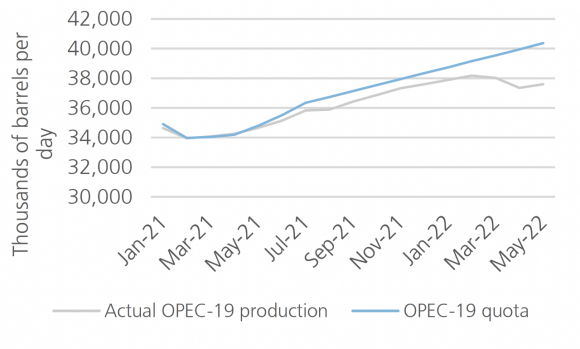
Structural support
Structural support
The green transition may be to this commodity cycle what Chinese demand was to the 2000s supercycle. And securing energy independence has become a more urgent concern for governments after Russia’s invasion of Ukraine exposed the flaws of relying on non-allied nations for basic necessities.
Barring a massive technological breakthrough, the green transition will be much harder, if not impossible, without strong supplies of copper, because of its superb conductivity. The long lead times for new mining projects to come online make it difficult to remedy supply/demand imbalances under tactical investment horizons. An overview of capital expenditures made by major producers of industrial metals suggests a major supply response is by no means in full swing (Exhibit 4).
Exhibit 4: Supply response in metals subdued versus last cycle
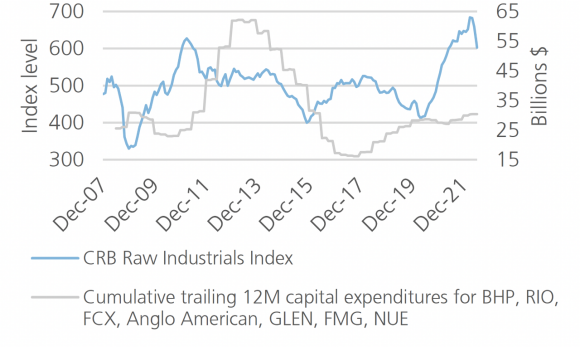
Risks to the thesis
Risks to the thesis
A more severe and sudden degradation of economic activity is the overarching risk to our optimistic call on commodities. The recent drop-off in US gasoline demand is a negative development that we will monitor closely, but do not expect will persist. Gasoline prices have fallen since this time, and nominal income growth is still running well above pre- pandemic norms.
Also, the pandemic is not fully behind us; a COVID-19 mutation that is both more contagious and virulent could reduce mobility and demand. This is particularly the case in China, where policymakers are more sensitive to outbreaks and higher-frequency indicators of mobility have reversed some of their recent gains. Saudi Arabia or Iran could also provide a positive supply shock in oil to help alleviate market imbalances, though we do not think this is likely.
A hard landing in the Chinese real estate sector – a tail risk, not our base case – would be quite negative for industrial metals. And certain developments would be good for some commodities and bad for others. For instance, if Europe were to ration natural gas supplies, this would likely be positive for energy-linked exposures (in part by spurring some gas-to-oil switching, where possible) but negative for metals via lower industrial production.
Over the medium term, a prolonged period of strong capital expenditures that boosted supply would undermine our bullish case. Government policies that sought to ensure more consistent availability of strategically important materials and energy would also likely reduce some near-term commodity upside when enacted, while raising longer-dated commodity futures. The disinflationary forces of technology and innovation could also play a role in reducing medium-term demand for commodities in ways that are not obvious, or even imaginable, at present.
Conclusion
Conclusion
We believe it still makes sense to be overweight commodities and associated equities despite the widespread concern over the growth outlook. Sentiment has shifted much more than the underlying fundamentals, with a mass exodus of investors from commodity-linked exchange-traded funds over the past month (Exhibit 5). Additionally, these assets are useful from a portfolio construction standpoint in hedging any additional geopolitically-induced negative supply shocks.
Energy and materials remain sectors that are extremely inexpensive relative to global stocks (Exhibits 6 & 7) despite having enjoyed a long period of significantly superior earnings revisions. While these are by no means recession-proof parts of the market, we believe that the cheapness does help cushion the magnitude of additional downside should threats to the expansion grow more intense.
As investors have been reminded recently, commodities are by no means a one-way ticket. We plan to be prudent in adjusting these exposures based on tactical considerations, as well as within commodity markets based on frictions between when incremental supply comes on line relative to increases in demand. In our view, the medium-term outlook is for supply to be lagging demand across many commodity markets – giving these assets staying power as an investment theme.
Exhibit 5: Slump in interest for commodity-linked equity funds
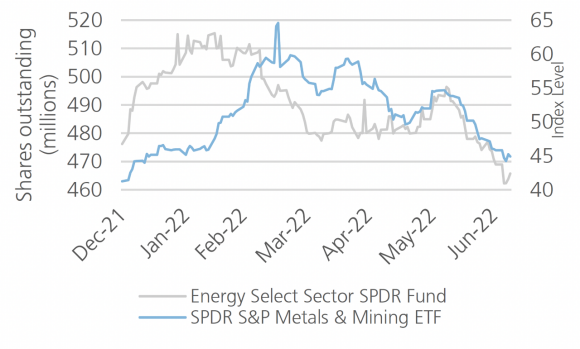
Exhibit 6: Attractive valuations in materials relative to global stocks
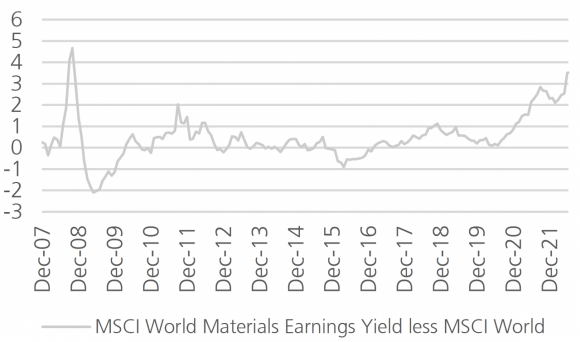
Exhibit 7: Energy stocks very cheap with favorable earnings trends
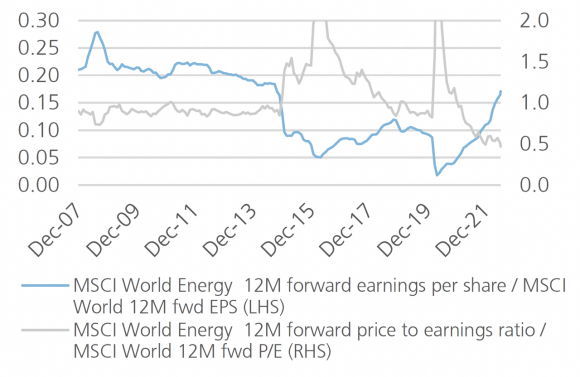
Asset class attractiveness (ACA)
The chart below shows the views of our Asset Allocation team on overall asset class attractiveness as of 7 July 2022. The colored squares on the left provide our overall signal for global equities, rates, and credit. The rest of the ratings pertain to the relative attractiveness of certain regions within the asset classes of equities, rates, credit and currencies. Because the ACA does not include all asset classes, the net overall signal may be somewhat negative or positive.
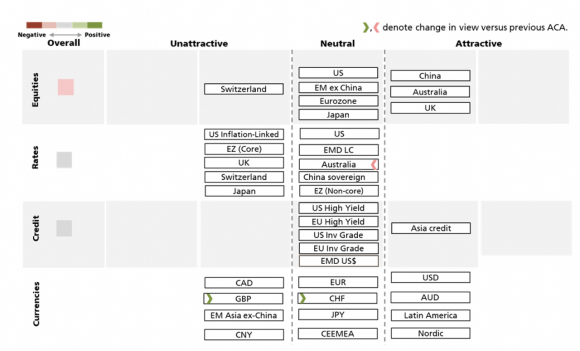
Asset Class | Asset Class | Overall/ relative signal | Overall/ relative signal | UBS Asset Management’s viewpoint | UBS Asset Management’s viewpoint |
|---|---|---|---|---|---|
Asset Class | Global Equities | Overall/ relative signal | Light red | UBS Asset Management’s viewpoint |
|
Asset Class | US Equities | Overall/ relative signal | Grey | UBS Asset Management’s viewpoint |
|
Asset Class | Ex-US Developed market Equities | Overall/ relative signal | Grey | UBS Asset Management’s viewpoint |
|
Asset Class | Emerging Markets (EM) Equities (ex-China) | Overall/ relative signal | Grey | UBS Asset Management’s viewpoint |
|
Asset Class | China Equities | Overall/ relative signal | Light Green | UBS Asset Management’s viewpoint |
|
Asset Class | Global Duration | Overall/ relative signal | Grey | UBS Asset Management’s viewpoint |
|
Asset Class | US Bonds | Overall/ relative signal | Grey | UBS Asset Management’s viewpoint |
|
Asset Class | Ex-US Developed-market Bonds | Overall/ relative signal | Light Red | UBS Asset Management’s viewpoint |
|
Asset Class | US Investment Grade (IG) Corporate Debt | Overall/ relative signal | Grey | UBS Asset Management’s viewpoint |
|
Asset Class | US High Yield Bonds | Overall/ relative signal | Grey | UBS Asset Management’s viewpoint |
|
Asset Class | Emerging Markets Debt US dollar Local currency | Overall/ relative signal | Grey Grey | UBS Asset Management’s viewpoint |
|
Asset Class | China Sovereign | Overall/ relative signal | Grey | UBS Asset Management’s viewpoint |
|
Asset Class | Currency | Overall/ relative signal | - | UBS Asset Management’s viewpoint |
|
A comprehensive solutions provider
A comprehensive solutions provider
UBS Asset Management Investment Solutions manages USD 170bn as of March 31, 2022. Our 100+ Investment Solutions professionals leverage the depth and breadth of UBS's global investment resources across regions and asset
classes to develop solutions that are designed to meet client investment challenges. Investment Solutions' macro-economic and asset allocation views are developed with input from portfolio managers globally and across asset classes.
For more information, contact your UBS Asset Management representative or your financial advisor.
Make an inquiry
Fill in an inquiry form and leave your details – we’ll be back in touch.
Introducing our leadership team
Meet the members of the team responsible for UBS Asset Management’s strategic direction.


